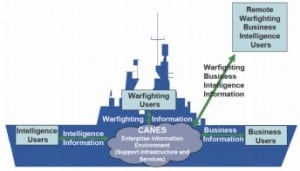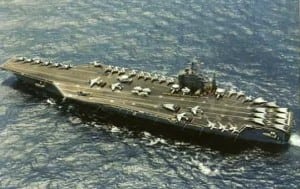The U.S. Navy is sharing insights from Project Overmatch with some allies and partners to help them all potentially fight together in the future.
“So some of our allies and partners, I’m not going to mention which ones, but those that we see a higher likelihood of interoperability in the near term, we are sharing our Project Overmatch work with them,” Adm. Mike Gilday, Chief of Naval Operations, said Wednesday during a virtual event hosted by the Atlantic Council.
The secretive Project Overmatch is the Navy’s portion of the Pentagon’s Joint All-Domain Command and Control (JADC2) effort.

In 2020, Gilday directed Rear Adm. Douglas Small, commander of Naval Information Warfare Systems Command (NAVWAR), to lead the project. At the time, they said the goal to build a new naval operational infrastructure that would help a future manned and unmanned force operate in a distributed manner and create a common operating picture to best connect sensors to match sensors and shooters (Defense Daily, Oct. 15, 2020).
Gilday said these allies and partners are “highly interested” and some of their heads of Navy have visited San Diego to visit Small and his team at NAVWAR.
“So it’s not lost on me the power of including them, we have to be inclusive, or we’re not going to be able to fight together. And so we’re moving forward, I think, in a good pace with our allies and partners in that effort. We’re not holding back.”
When asked if the partners need to undergo any technology development to grow in a parallel way, Gilday said the technology the U.S. Navy is using to package any data set and send it to any network is applicable to almost any network.
“So whatever networks that they have, that we don’t currently have a like investment in, I still think that technically that we could solve that problem in terms of allowing that to be part of the framework.”
However, the CNO said cyber resiliency is part of the effort “that one can’t ignore and becomes an important piece of it. So that has to be baked in to any new network that we add and we experiment with.”
In January, Rear Adm. James Downey, program executive officer for carriers, confirmed the Navy still had plans to add upgraded Project Overmatch capabilities to four unspecified aircraft carriers in the coming years (Defense Daily, Jan. 25).

The Navy plans to start by delivering a minimally viable product (MVP) of Project Overmatch systems to the Theodore Roosevelt Carrier Strike Group (TRCSG) in fiscal year 2023 during a modernization period (Defense Daily, Feb. 9, 2021).
The MVP is expected to include networks, certain configurations of the Consolidated Afloat Networks and Enterprise Services (CANES) networking gear, certain sets of management aides and planners, and defining data structure from the first increment of overmatch capability.
In January, Downey confirmed the modernization required to install Project Overmatch capabilities on U.S. carriers is not minor, but also does not require significant hull, mechanical or electrical changes either.
When asked on Thursday what the Project Overmatch exercises may include as it starts to get tested on the first carrier, the Secretary of the Navy Carlos Del Toro was unwilling to go into details due to its top secret nature.
“I’m not going to go into the details of what it is and how we’re going to roll it out. I will say that we’re deeply dedicated to its success in every possible way. It supports JADC2 in every possible way across the joint force,” Del Toro said during a Professional Services Council Defense Conference on Oct. 20.
However, he did reveal Deputy Secretary of Defense Kathleen Hicks recently got an update on Project Overmatch during a visit to San Diego.
“I know that she’s excited about the capabilities that it brings. I’m very dedicated to making it a successful program. And it’s going to be transformational in the way that all our weapons systems communicate together as a joint force. And the amount of talent, energy, money that we’re putting into it is respectable.”
Del Toro added that “I’m not going to tell the Chinese what we’re up to either…but, otherwise, I’m just very excited that we have that capability and that we’re going to be employing it throughout the fleet sooner than later.”